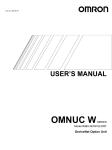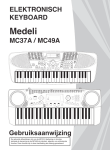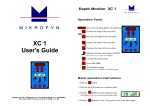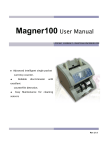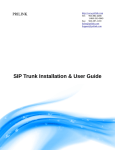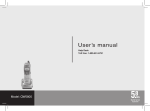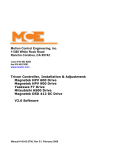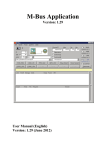Download ML-23 / ML-24 User Manual
Transcript
PRECISION LASERS ML-23 / ML-24 User Manual Version 1.0 English ML-23 ML-24, Introduction 2 Introduction Purchase Congratulations on the purchase of a Mikrofyn laser instrument. This manual contains important safety directions as well as instructions for setting up the product and operating it. Refer to "9 Safety Directions" for further information. Read carefully through the User Manual before you switch on the product. Product identification The model and the serial number of your product are indicated on the type plate. Enter the model and serial number in your manual and always refer to this information when you need to contact your agency or Mikrofyn authorized service workshop. Type-Serial No.: ML-23_______________ ML-24_______________ Date of purchase: ____________________ Symbols The symbols used in this manual have the following meanings: Type Description Danger Indicates an imminently hazardous situation which, if not avoided, will result in death or serious injury. Warning Indicates a potentially hazardous situation or an unintended use which, if not avoided, could result in death or serious injury. Caution Indicates a potentially hazardous situation or an unintended use which, if not avoided, may result in minor or moderate injury and/or appreciable material, financial and environmental damage. ) ML-23 ML-24, Introduction Important paragraphs which must be adhered to in practice as they enable the product to be used in a technically correct and efficient manner. 3 ML-23 ML-24, Table of Contents 4 Table of Contents In this manual Chapter Page 1 Introduction 6 2 Features and Functions 9 3 Setup 3.1 3.2 3.3 General Setup Setup Options Additional Setup Options 11 11 12 15 4 Operation 4.1 General 4.2 Entering Grade 4.3 Identification of the Axes 4.4 Slope - Percent of Grade 4.5 Alignment of the Axes 17 17 17 19 19 20 5 Checking Level Accuracy 5.1 Procedure 5.2 Adjusting Level Accuracy 21 21 22 6 Accessories 6.1 Batteries 6.2 Remote Control RC-24 24 24 26 7 Troubleshooting 7.1 Screen Explanations 7.2 Troubleshooting Suggestions 30 30 33 8 Care and Transport 8.1 Transport 8.2 Storage 8.3 Cleaning and Drying 35 35 36 37 9 Safety Directions 9.1 General 9.2 Intended Use 9.3 Limits of Use 9.4 Warranty 9.5 Responsibilities 9.6 Hazards of Use 9.7 Laser Classification 9.8 Electromagnetic Compatibility (EMC) 9.9 FCC Statement, Applicable in U.S. 38 38 38 39 39 40 41 46 50 52 10 Technical Data 55 ML-23 ML-24, Table of Contents 5 ML-23 ML-24, Introduction 1 6 Introduction General information This manual contains operating and setup procedures for common applications. Its purpose is to describe the features of the laser and how the laser operates. The manual is not intended to describe specific applications. Contact your local dealer or Mikrofyn for information specific to your jobsite requirements. The Mikrofyn grade laser is designed to serve your needs in a wide variety of applications. It is a proven tool for increased production with substantial reduction of labour, time and material costs. It can be used to accurately control sloped or level grading, trenching, open cut mining, dredging, contouring of levees, general construction and excavation. Features ML-23 ML-24, Introduction Feature ML-23 ML-24 RF remote control 9 Dual grade to ± 15% 9 Single grade to ± 15% 9 9 Fully automated grade control 9 9 Beam masking 9 9 Bright, visible beam 9 9 Large, intuitive, graphic display 9 9 Simple, five-button operation 9 9 7 ML-23 ML-24, Introduction Area of application 8 Single grade The ML-23 is a single grade laser and is capable of producing an accurate plane of laser light for applications which require level (1) or single slope (2). 1 2 Dual grade 1 2 3 The ML-24 is a dual grade laser and is capable of producing an accurate plane of laser light for applications that require level (1), single slope (2) or dual slope (3). 2 Features and Functions Overview a) b) c) d) e) f) g) h) i) j) Buttons Button ML-23 ML-24, Features and Functions X/Y button MENU button POWER button X button (ML-23 only) Easy grip handle UP button DOWN button LCD display Battery Tripod mount Function POWER button Press shortly to switch the laser on or activate backlight. Press and hold for 1.5 seconds to switch the laser off. X button Press to set grade in the X-axis. (ML-23 only) Throughout this manual, the X/Y button will be used when referring to either the X or X/Y button. X/Y button Press to set grade in the X- and Y-axis. (ML-24 only) UP button After pressing X/Y, press to increase the grade shown. 9 ML-23 ML-24, Features and Functions 10 Button Components Function DOWN button After pressing X/Y, press to decrease the grade shown. MENU button Press to enter setup screens and the grade entry by digit screen. Component Function LCD display Shows the grade setting for the X- and Y-axis. The display shows also beam masking, battery status, H.I. and head speed. Easy grip handle For carrying and setup. Tripod mount For attachment to a tripod with 5/8”-11 mounting thread. Description: main screen a bc d e f g h i j a) b) c) d) e) f) g) h) i) j) X-axis grade Y-axis grade Progress bar Beam masking Remote status Lock status Battery status H.I. alert Head speed Status line 3 3.1 Setup General Setup Location Make sure the location is clear of possible obstructions that may block or reflect the laser beam. Make the most efficient use of the laser’s operating radius. The laser can be placed in the center of the working area or to one side. Make sure the ground is stable. Ground vibration and extremely windy conditions can affect the operation and accuracy of the laser. If working in very dusty conditions, place the laser up-wind. The dirt will then be blown away from the laser and reduce interference. Recommended head speeds The typical head speed for general construction applications is 10 rps (600 rpm). When working at extended distances, decreasing the head speed (increasing the pulse time on the receiver) or changing the band width of the receiver to wide band can improve the laser range and performance. Tripod setup Attach the laser securely to a tripod or mount it on a stable level surface. Always check the tripod before beginning work. Make sure all screws, bolts and nuts are tight. If your tripod has chains, they should be slightly loose to allow for thermal expansion during the day. On extremely windy days, secure the tripod, for example, by placing a sandbag on each leg. If using a tripod with a quick disconnect adapter, point the control lever into the wind. This places the locking mechanism also into the wind and will provide better stability. To make use of the extended grade capability, make sure the laser is mounted on the tripod with the display directly over one leg. ML-23 ML-24, Setup 11 ML-23 ML-24, Setup 3.2 12 Setup Options Description The laser has several setup options that are easily accessed and changed in the setup screen. From the main screen, press the MENU button to access the setup screen. Use the UP and DOWN buttons to move the cursor. Use the MENU button to select the setup parameters. Use the UP and DOWN buttons to change the selected parameter. Press the MENU button to accept the change. Select EXIT and press the MENU button to return to the main screen. Parameters Head speed. H.I. function: Turns the H.I. function on and off. Automatic or manual mode. Beam masking: Turns the beam off in the selected sectors. Lock function: Protects the laser against unwanted changes. ) If no button is pressed, the display will revert to the main screen after ten seconds and stores possible changes. Head speeds • 5 or 10 rps (300 or 600 rpm). Select the head speed that provides the best performance for your application. The selected head speed is shown in the status line. H.I. function The H.I. (Height of Instrument) function is used to alert for critical elevation changes caused by movement of the tripod. When the H.I. function is turned on, the letters “HI” will appear in the status line. The H.I. function becomes active 30 seconds after the laser has completely leveled, the head starts rotating and the self-leveling accuracy remains the same. The laser will trigger an H.I. alert if it has to re-level beyond the limit. The laser will stop rotating and the following screen will appear on the display: ) ML-23 ML-24, Setup Stop the alert condition by pressing the MENU or POWER button. In any case the laser relevels, sets the grade and re-activates the H.I. function. Carefully check the setup and elevation of the laser to determine what has caused the alert condition. Adjust as required to the correct elevation. 13 ML-23 ML-24, Setup Automatic mode 14 ) The laser will always turn on in automatic mode and will continuously self-level to maintain grade accuracy. To indicate automatic mode, the display shows: The X-axis slope can be changed by pressing the X/Y button first and then the MENU button to enter the grade entry by digit screen. Refer also to chapter "4.2 Entering Grade". Manual mode ) In manual mode the self-leveling function and the H.I. function are not available. To indicate manual mode, the display shows: In manual mode the X-axis slope can be changed by pressing the X/Y button first and then the UP button / DOWN button to change the amount. The amount of change is not visible on the display. Beam masking Electronic beam masking allows for turning off the laser beam in specific sectors to prevent interference with other operations on the job. Using the setup menu the beam can be turned off in two or three selected sectors. The beam masked sectors will appear dark. Lock function The lock function is used to prevent the laser against unwanted changes. When the lock function is activated, the laser remains operational, but no settings can be changed. The lock status is shown in the status line. Once activated and pushing a button, the lock symbol will be shown for three seconds. To turn OFF the lock function, press the MENU button to return to the setup screen and disable the lock. Even if the laser is locked, the backlight can be switched on by pressing the POWER button shortly. Press and hold the POWER button to switch the laser OFF. 3.3 Additional Setup Options Description Display contrast ML-23 ML-24, Setup Additional setup options may be accessed in a second setup screen. From the main screen, press and hold the UP + button, then press the MENU button to access the second setup screen. The display contrast of the laser can be adjusted. The display contrast range goes from -8 (low) to +8 (high). 15 ML-23 ML-24, Setup 16 Sensitivity The sensitivity setting allows the laser to operate in adverse environmental and windy conditions, while still ensuring maximum accuracy. The sensitivity can be set to Sensitivity Level SL1 or Sensitivity Level SL2. Select "SL1" for normal conditions. Select "SL2" for very adverse conditions. Remote function The remote function is enabled only when a remote is to be used with the ML-24. It is normally off to save battery power. Only the ML-24 is remote capable and will show the remote function. ) 4 Operation 4.1 General Backlight Per default the backlight is always off. To switch on the backlight, press the POWER button shortly. Settings All setup options are stored when the laser is turned off. Temperature compensation After the laser has been turned on, the temperature is measured. If the temperature changes by more than 5°C / 9°F it compensates and applies this change to the levelling system when grade has been entered. The temperature compensation process is indicated by a progress bar (a). During this process, head rotation stops and the laser beam is a turned off. Once completed the laser returns back to the grade and the head starts to rotate. 4.2 Entering Grade Direct grade entry Press X/Y once to enter X-axis grade. Press X/Y again to enter Y-axis grade. The display will show the grade entry screens. Use the UP or DOWN buttons to set the desired grade. ML-23 ML-24, Operation 17 ML-23 ML-24, Operation 18 Press X/Y to exit and store values. Grade entry by digit While in the grade entry screens, press the MENU button and a cursor will appear on the ± sign. Press the MENU button to move the cursor to the right. Press the UP or DOWN button to change the sign or the digit that is highlighted. Press X/Y to exit and store values. Grade zero In grade entry mode, the grade in either axis can quickly be set to zero by pressing both the UP and DOWN buttons simultaneously. Grade capability • ML-23: ±15% in one axis. • ML-24: ±15% in both axes simultaneously. ) Grade swap On a ML-23 / ML-24 to reach more than 10% of grade the laser must be tilted towards the target plane. The grade values of an axis can easily be swapped from positive to negative in the grade entry by digit screen. 4.3 Identification of the Axes Description a b c 4.4 a) X+ axis When positive grade is entered in the X-axis, grade will increase in this direction. b) Y+ axis When positive grade is entered in the Y-axis, grade will increase in this direction. c) Front of laser Slope - Percent of Grade Description ML-23 ML-24, Operation • Slope: The change in elevation per unit of measure (foot, meter, etc.). • Percent of grade: The change in elevation per 100 units of measure (feet, meters, etc.). • Calculating percent of grade from the slope: Slope = 0.0059 Conversion = 0.0059 x 100 Percent of Grade = 0.590% 19 ML-23 ML-24, Operation 4.5 20 Alignment of the Axes Description When the desired grade is correctly set in the display, it is necessary to align the X and Y axes to the jobsite. Ensure the laser is properly positioned over a control point. As shown, the direction of the X-axis is seen from the front of the laser, sighting over the top. Rotate the laser slightly until the sightlines are aligned with your second control point. Once aligned, work can begin. 5 Checking Level Accuracy ) 5.1 • It is the responsibility of the user to follow operating instructions and to periodically check the accuracy of the instrument and work as it progresses. • The laser is adjusted to the defined accuracy specification at the factory. It is recommended to check your laser for accuracy upon receipt and periodically thereafter to ensure accuracy is maintained. If your laser requires adjustment, contact your nearest authorized service center or adjust the laser using the following procedure. • Do not enter this mode or attempt adjustment unless you plan to change the accuracy. Accuracy adjustment should be performed only by a qualified individual that understands basic adjustment principles. Procedure ) To check level accuracy of your laser, place the laser on a flat, level surface or tripod approximately 30 m (100 ft) from a wall. Checking the X-axis 1 2 ML-23 ML-24, Checking Level Accuracy 1. Align the X-axis so that it is perpendicular to the wall. Allow the laser to self-level completely, and then, using your Rod Eye receiver, mark the position of the beam (Position 1). 2. Rotate the laser 180°, allow it to self-level and then mark the opposite side of the X-axis (Position 2). 21 ML-23 ML-24, Checking Level Accuracy 22 1 2 Checking the Y-axis 5.2 3. Mark the position half-way between the two marks. The X-axis is within its accuracy specification if the two marks are within ± 1/16” (± 1.5 mm) from center. Align the Y-axis by rotating the laser 90° so that the Y-axis is now square to the wall. Allow the laser to self-level completely then check the Y-axis in the same way as described for checking the X-axis. Adjusting Level Accuracy Enter adjustment mode X-axis accuracy adjustment With the laser turned off, press and hold both the UP and DOWN buttons then press the POWER button to put the laser in adjustment mode. ) Wait until the hour glass disappears before checking and changing the adjustment numbers. Use the UP and DOWN buttons to change the number and move the beam to the half-way point between the positions marked for the X-axis. 5 counts in the display (one button press) are equal to approximately 0.3 mm at 30 m (0.01” at 100 ft). Press the MENU button to accept the number in the display for the X-axis and move to the Y-axis adjustment screen. Y-axis accuracy ) Wait until the hour glass disappears before checking and changing the adjustment numbers. Use the UP and DOWN buttons to change the number and move the beam to the half-way point between the positions marked for the Y-axis. Press the MENU button to accept and store the number in the display for the Y-axis and to return to the main screen. ) • After adjustment, always check your work. • Always check accuracy prior to critical applications. • Pressing the POWER button at any time before completing the procedure will cancel the adjustment and revert the accuracy to previously saved information. ML-23 ML-24, Checking Level Accuracy 23 ML-23 ML-24, Accessories 6 Accessories 6.1 Batteries Description 24 The laser is powered by a rechargeable 7.2V NiMH MakitaTM type battery. A complete recharge of the battery in the supplied charger takes about 1 hour. The red LED on the charger will light when charging. When the LED goes out, the battery is fully recharged. A fully recharged battery has a capacity of about 30 hours of operation. Inserting the battery To place the battery in the laser, first unscrew the two finger screws on the battery lid, then insert the battery with the negative pole upwards and the poles towards the instrument. The battery should slide in easily, except for the last 1 cm (1/2"). It is important that no violence is used when inserting the battery. a OUT ) a) Metal To ensure that the battery is kept dry, inspect that the battery compartment cover and gasket are okay. If the battery compartment is wet, dry the laser without the battery and lid at a max. 50°C (122°F). Battery status The battery status is displayed as a small icon in the status line. Refer to "Description: main screen" on page 10. Low battery If the battery pack runs low on power, the low battery screen is shown. If NiMH batteries are used, it's strongly recommended to fully recharge them as soon as possible in order to extend their lifetime. ) Charging / First time use • The batteries must be charged prior to using it for the first time because it is delivered with an energy content as low as possible. • The permissible temperature range for charging is between 0°C to +40°C (+32°F to +104°F). For optimal charging we recommend charging the batteries at a low ambient temperature of 0°C to +20°C (+32°F to +68°F) if possible. • It is normal for the battery to become warm during charging. Using the chargers recommended by Mikrofyn, it is not possible to charge the battery if the temperature is too high. • For new batteries or batteries that have been stored for a long time (> three months), it is effectual to make 3-5 charge/discharge cycles. Operation / discharging • The batteries can be operated from -20°C to +50°C (-4°F to +122°F). • Low operating temperatures reduce the capacity that can be drawn; very high operating temperatures will reduce the service life of the battery. ML-23 ML-24, Accessories 25 ML-23 ML-24, Accessories 6.2 26 Remote Control RC-24 Description The Remote Control is a full functioning, two-way remote control. Only the ML-24 supports use of the Remote Control. ) All buttons on the remote except the SLEEP button have the same functionality as on the laser. ) Remote symbol status Before you can use the remote it is necessary to enable the remote capability on the laser. To do this, refer to "Remote function" on page 16. The remote symbol will appear in the status line of the main screen of the laser. Remote disabled. Remote enabled, but not connected. Remote enabled and connected to laser. POWER button The POWER button turns on the remote. When pressed it will communicate with the laser to receive current information. Once communication is established, the remote can be used to change grade and setup parameters on the ML-24. Press and hold the POWER button for 1.5 seconds to turn the remote off. If the remote is not within range or otherwise loses communication, the lost communication screen will be displayed. ) STANDBY button It is important to achieve the specified distances that the remote is used within the “line of sight” of the laser. The STANDBY button will cause the laser to go into standby mode for up to 16 hours. After this time the laser will shut off and can only be turned on again at the laser. In standby mode, a sleeping laser is shown. Pressing any button on the laser or on the remote (except the POWER button on the remote) will cause the laser to return to normal operation. Automatic shut off ML-23 ML-24, Accessories To save battery power, the remote will automatically shut off after two minutes of non-use. 27 ML-23 ML-24, Accessories Low battery 28 The remote will display a low battery screen when the batteries have reached a voltage where the remote can no longer communicate with the laser. To replace the batteries, remove the bottom cover of the housing. Install as indicated on the side of the housing. Programming the remote ) Make sure the remote is switched off prior to programming. To program the remote to work with a specific laser, press and hold the MENU button then press the POWER button. The remote will search the immediate area for ML-24 units with remote capability, and will identify these in the display. To select your laser, highlight the serial number and press the MENU button. The remote will connect to the selected laser. To exit this screen without changing settings, highlight EXIT and press the X/Y button. Shut-off timer The remote is set from the factory to shut off after two minutes of not being used. To change this shut-off time, enter the remote programming screen by pressing and holding the MENU button, then pressing the POWER button. When the laser select screen is shown, press and hold the STANDBY button for 1.5 seconds. The shut-off time will change between 120, 60, or 30 seconds each time the button is held. Backlight The LCD backlighting is normally turned off to conserve battery power. To backlight the display on the remote, press the POWER button a second time after the remote has been turned on. Remote reception The remote is an RF (radio frequency) device with an internal antenna. Always ensure that the remote is within the “line of sight” of the ML-24. If the remote loses communication, hold the remote at a different angle to improve reception. ML-23 ML-24, Accessories 29 ML-23 ML-24, Troubleshooting 7 7.1 30 Troubleshooting Screen Explanations General screens Initial start-up screen • Mikrofyn logo and software version is shown. • If service is required, please always provide the software version which is shown on the bottom line. Customer name screen • Can be programmed to display customer’s name and address. • Contact your dealer for more details. Standby mode • Controlled by the STANDBY button on the remote. • Press the POWER button on the laser to turn off. • Standby mode is only available on a ML-24 if connected to an Remote Control. Alert screens H.I. alert • The laser has moved and elevation may have changed. • Press the POWER or MENU button to reset H.I. function. • Check laser’s elevation and adjust if required. Servo limit • The laser cannot reach level or grade position. • Tilt it in direction as indicated by the arrows. Tilt • The laser is tilted at an angle of more than 20 degrees. Lock symbol • The laser is locked and does not allow any changes. • Power on/off is still possible. • To unlock, press the MENU button and go to the setup screen. Temperature • The laser is too hot or cold to operate properly. • Shade the laser if too hot. • Warm the laser before continuing if too cold. Lost communication • The remote is out of range. Move closer. • The remote is not in the "line of sight" of the laser. ML-23 ML-24, Troubleshooting 31 ML-23 ML-24, Troubleshooting 32 Low battery • Shown if laser battery runs low on power. • Rechargeable batteries must be recharged as soon as possible. Vibration • The laser cannot level due to excessive vibration or wind. • Tighten or sandbag your tripod, move the laser away from sources of vibration. • Change sensitivity to 'SL2' for adverse conditions. • Press the MENU button to restart levelling. 7.2 Troubleshooting Suggestions Description Whenever there are questions regarding your laser, check the basics first. • Mode of operation: automatic or manual. • Battery status. • Alert screens: H.I., servo limit, temperature, adjustment. • Head speed setting. • Beam mask setting. Symptom Possible causes and solutions No beam Check with a receiver to verify. No self-leveling Manual mode, set to automatic mode. Cannot change grade • Check the other axis. • Check operation in manual mode. • Check if at grade limit. Loss of distance • Check the window surfaces. • Check with a different receiver. • At extended distances, decreasing the head speed may improve performance. Grade stakes do not • Check for proper alignment of the axes. match the laser • Check level accuracy of the laser. • Check the grade stakes to verify their accuracy or to determine if they have moved. Remote will not turn on ML-23 ML-24, Troubleshooting Check and replace the batteries. 33 ML-23 ML-24, Troubleshooting ) 34 Symptom Possible causes and solutions Remote will not communicate with the ML-24 • Check that remote capability is enabled on the ML-24. (See small icon on the main screen) • Check remote battery status. • Reduce distance and try again. • At longer distances, ensure the remote is in the “line of sight” of the ML-24. • Position the remote more upright to improve distance. Setup options • The laser is locked. cannot be changed • Unlock the laser in the setup screen. If none of the above suggestions results in a solution, contact your local dealer or nearest authorized service center. 8 8.1 Care and Transport Transport Transport in the field When transporting the product in the field, always make sure that you: • Either carry the instrument in its original transport case • Or carry the tripod with its legs splayed across your shoulder, keeping the attached instrument upright. Transport in a road vehicle Never carry the instrument loose in a road vehicle. It can be affected by shock and vibration. Always carry the product in its transport container and secure it. Shipping When transporting the product by rail, air or sea, always use the complete original Mikrofyn packaging transport container and cardboard box, or its equivalent, to protect against shock and vibration. Shipping, transport of batteries When transporting or shipping batteries, the person in charge of the product must ensure that the applicable national and international rules and regulations are observed. Before transportation or shipping, contact your local passenger or freight transport company. Field adjustment After transport inspect the level accuracy in this user manual before using the product. ML-23 ML-24, Care and Transport 35 ML-23 ML-24, Care and Transport 8.2 36 Storage Product Respect the temperature limits when storing the product, particularly in summer if the instrument is inside a vehicle. Refer to "10 Technical Data" for information about temperature limits. Field adjustment After long periods of storage inspect the level accuracy given in this user manual before using the product. Nickel-Metal Hydride batteries • Refer to "10 Technical Data" for information about storage temperature range. • Fully charged NiMH batteries can be stored for a maximum of 180 days. NiMH batteries must then be recharged again. • Remove the batteries from the product for storage. • After storage, recharge the batteries before use. • Protect batteries from damp and wetness. Wet or damp batteries must be dried before storing or use. 8.3 Cleaning and Drying Product and accessories • Blow dust off optical parts. • Never touch the glass with your fingers. • Use only a clean, soft, lint-free cloth for cleaning. If necessary, moisten the cloth with water or pure alcohol. • Do not use other liquids; these may attack the polymer components. Damp Products • Dry the product, the transport container, the foam inserts and the accessories at a temperature not greater than 40°C / 104°F and clean them. • Do not repack until everything is completely dry. • Always close the transport container when using in the field. Cables and plugs • • Keep plugs clean and dry. Blow away any dirt lodged in the plugs of the connecting cables. ML-23 ML-24, Care and Transport 37 ML-23 ML-24, Safety Directions 9 9.1 Safety Directions General Description 9.2 38 The following directions should enable the person responsible for the product, and the person who actually uses the equipment, to anticipate and avoid operational hazards. The person responsible for the product must ensure that all users understand these directions and adhere to them. Intended Use Permitted use • The product casts a horizontal laser plane or a laser beam for the purposes of alignment. • The product can be set up on its own baseplate or on a tripod. • The laser beam can be detected by means of a laser detector. • Remote control of product. • Data communication with external appliances. Adverse use • Use of the product without instruction. • Use outside of the intended limits. • Disabling safety systems. • Removal of hazard notices. • Opening the product using tools, for example screwdriver, unless this is specifically permitted for certain functions. • Modification or conversion of the product. • Use after misappropriation. • Use of products with obviously recognizable damages or defects. • Use with accessories from other manufacturers without the prior explicit approval of Mikrofyn. • Inadequate safeguards at the construction site, for example when using on or near roads. • Deliberate dazzling of third parties. • Controlling of machines, moving objects or similar monitoring application without additional control and safety installations. 9.3 Limits of Use Environment Suitable for use in an atmosphere appropriate for permanent human habitation: not suitable for use in aggressive or explosive environments. 9.4 Warning Adverse use can lead to injury, malfunction, and material damage. It is the task of the person responsible for the equipment to inform the user about hazards and how to counteract them. The product is not to be used until the user has been instructed how to work with it. Danger Local safety authorities and safety experts must be contacted before working in hazardous areas, or in close proximity to electrical installations or similar situations by the person in charge of the product. Warranty Description Mikrofyn warrants the ML-23 / ML-24 to be free of defects in materials and workmanship under normal use and service for a period of 24 months, provided that the product has been properly used and cared for as stated in the User Manual. Any evidence of an attempt to repair the ML-23 / ML-24 by other than factory authorised personnel using Mikrofyn certified replacement parts will automatically void the warranty. The foregoing warranty is exclusive and is in lieu of all other warranties, terms or conditions, express or implied, either in fact or by operation of law, statutory or otherwise, including ML-23 ML-24, Safety Directions 39 ML-23 ML-24, Safety Directions 40 warranties, terms or conditions of merchantability, fitness for a particular purpose, satisfactory quality and non-infringement, all of which are expressly disclaimed. 9.5 Responsibilities Manufacturer of the product Mikrofyn A/S, hereinafter referred to as Mikrofyn, is responsible for supplying the product, including the user manual and original accessories, in a completely safe condition. Manufacturers of nonMikrofyn accessories The manufacturers of non Mikrofyn accessories for the product are responsible for developing, implementing and communicating safety concepts for their products, and are also responsible for the effectiveness of those safety concepts in combination with the Mikrofyn product. Person in charge of the product The person in charge of the instrument has the following duties: • To understand the safety instructions on the product and the instructions in the user manual. • To be familiar with local regulations relating to accident prevention. • To inform Mikrofyn immediately if the product and the application becomes unsafe. • To ensure that the national laws, regulations and conditions for the operation of radio transmitters are respected. Warning The person responsible for the product must ensure that it is used in accordance with the instructions. This person is also accountable for the training and the deployment of personnel who use the product and for the safety of the equipment in use. 9.6 Hazards of Use Warning The absence of instruction, or the inadequate imparting of instruction, can lead to incorrect or adverse use, and can give rise to accidents with far-reaching human, material, financial, and environmental consequences. Precautions: All users must follow the safety directions given by the manufacturer and the directions of the person responsible for the product. Caution Watch out for erroneous measurements if the product has been dropped or has been misused, modified, stored for long periods or transported. Precautions: Periodically carry out test measurements and perform the field adjustments indicated in the user manual, particularly after the instrument has been subjected to abnormal use and before and after important measurements. Danger Because of the risk of electrocution, it is very dangerous to use grade rods and staffs in the vicinity of electrical installations such as power cables or electrical railways. Precautions: Keep at a safe distance from electrical installations. If it is essential to work in this environment, first contact the safety authorities responsible for the electrical installations and follow their instructions. ML-23 ML-24, Safety Directions 41 ML-23 ML-24, Safety Directions 42 Warning If the product is used with accessories, for example masts, staffs, poles, you may increase the risk of being struck by lightning. Precautions: Do not use the product in a thunderstorm. Warning Inadequate securing of the work site can lead to dangerous situations, for example in traffic, on building sites, and at industrial installations. Precautions: Always ensure that the work site is adequately secured. Adhere to the regulations governing accident prevention and road traffic. Caution If the accessories used with the product are not properly secured and the product is subjected to mechanical shock, for example blows or falling, the product may be damaged or people may sustain injury. Precautions: When setting up the product, make sure that the accessories, for example tripod, tribrach, connecting cables, are correctly adapted, fitted, secured, and locked in position. Avoid subjecting the equipment to mechanical stress. Caution During the transport, shipping or disposal of batteries it is possible for inappropriate mechanical influences to constitute a fire hazard. Precautions: Before shipping the product or disposing of it, discharge the batteries by running the product until they are flat. When transporting or shipping batteries, the person in charge of the product must ensure that the applicable national and international rules and regulations are observed. Before transportation or shipping contact your local passenger or freight transport company. Warning During dynamic applications, there is a danger of accidents occurring if the user does not pay attention to the environmental conditions around, for example obstacles, excavations or traffic. Precautions: The person responsible for the product must make all users fully aware of the existing dangers. Operation of Charger: Danger The charger is not designed for use under wet and severe conditions. If unit becomes wet it may cause you to receive an electric shock. Precautions: Use the charger only in dry environments, for example in buildings or vehicles. Protect the product against humidity. If the charger becomes humid, it must not be used! Operation of Charger: Warning If you open the product, either of the following actions may cause you to receive an electric shock: • Touching live components ML-23 ML-24, Safety Directions 43 ML-23 ML-24, Safety Directions 44 • Using the product after incorrect attempts were made to carry out repairs. Precautions: Do not open the product. Only Mikrofyn authorized service workshops are entitled to repair these products. Warning Batteries not recommended by Mikrofyn may be damaged if charged or discharged. They may burn and explode. Precautions: Only charge and discharge batteries recommended by Mikrofyn. Warning If the product is improperly disposed of, the following can happen: • If polymer parts are burnt, poisonous gases are produced which may impair health. • If batteries are damaged or are heated strongly, they can explode and cause poisoning, burning, corrosion or environmental contamination. • By disposing of the product irresponsibly you may enable unauthorized persons to use it in contravention of the regulations, exposing themselves and third parties to the risk of severe injury and rendering the environment liable to contamination. Precautions: The product must not be disposed with household waste. Dispose of the product appropriately in accordance with the national regulations in force in your country. Always prevent access to the product by unauthorized personnel. Warning Only Mikrofyn authorised service workshops are entitled to repair these products. Warning Using a battery charger not recommended by Mikrofyn can destroy the batteries. This can cause fire or explosions. Precautions: Only use chargers recommended by Mikrofyn to charge the batteries. Warning High mechanical stress, high ambient temperatures or immersion into fluids can cause leakage, fire or explosions of the batteries. Precautions: Protect the batteries from mechanical influences and high ambient temperatures. Do not drop or immerse batteries into fluids. Warning Short circuited battery terminals can overheat and cause injury or fire, for example by storing or transporting in pockets if battery terminals come in contact with jewelry, keys, metallized paper or other metals. Precautions: Make sure that the battery terminals do not come into contact with metallic objects. ML-23 ML-24, Safety Directions 45 ML-23 ML-24, Safety Directions 9.7 46 Laser Classification Description The following directions (in accordance with the statement of the art - international standard IEC 60825-1 (2007-03) and IEC TR 60825-14 (2004-02)) provide instruction and training information to the person responsible for the product and the person who actually uses the equipment, to anticipate and avoid operational hazards. The person responsible for the product must ensure that all users understand these directions and adhere to them. Product classified as laser class 1, class 2 and class 3R do not require: • Laser safety officer involvement • Protective clothes and eyewear • Special warning signs in the laser working area if used and operated as defined in this user manual due to the low eye hazard level. Products classified as laser class 2 or 3R may cause dazzle, flash-blindness and afterimages, particularly under low ambient light conditions. ) ) General The rotating laser produces a visible red laser beam which emerges from the rotating head. The laser product described in this section, is classified as laser class 2 in accordance with • IEC 60825-1 (2007-03): “Safety of laser products” • EN 60825-1 (2007-10): “Safety of laser products” Class 2 laser products are safe for momentary exposures but can be hazardous for deliberate staring into the beam. ML-23 / ML-24 Description Value Maximum peak radiant power 2.7 mW ± 5% Pulse duration (effective) 2.2, 1.1 ms Description Value Pulse repetition frequency 5, 10 rps Beam divergence < 1.5 mrad Wavelength 635 ± 10 nm Warning From a safety perspective class 2 laser products are not inherently safe for the eyes. Precautions: Avoid staring into the beam. ML-23 ML-24, Safety Directions 47 ML-23 ML-24, Safety Directions 48 Labelling ML-23 a Laser Radiation Do not stare into the beam Class 2 Laser Product According to IEC 60825-1 (2007 – 03) Po ≤ 2.7 mW λ = 635 ± 10 nm a) Laser beam Labelling ML-24 a Laser Radiation Do not stare into the beam Class 2 Laser Product According to IEC 60825-1 (2007 – 03) Po ≤ 2.7 mW λ = 635 ± 10 nm a) Laser beam ML-23 ML-24, Safety Directions 49 ML-23 ML-24, Safety Directions 9.8 50 Electromagnetic Compatibility (EMC) Description The term Electromagnetic Compatibility is taken to mean the capability of the product to function smoothly in an environment where electromagnetic radiation and electrostatic discharges are present, and without causing electromagnetic disturbances to other equipment. Warning Electromagnetic radiation can cause disturbances in other equipment. Although the product meets the strict regulations and standards which are in force in this respect, Mikrofyn cannot completely exclude the possibility that other equipment may be disturbed. Caution There is a risk that disturbances may be caused in other equipment if the product is used in conjunction with accessories from other manufacturers, for example field computers, personal computers, two-way radios, non-standard cables or external batteries. Precautions: Use only the equipment and accessories recommended by Mikrofyn. When combined with the product, they meet the strict requirements stipulated by the guidelines and standards. When using computers and two-way radios, pay attention to the information about electromagnetic compatibility provided by the manufacturer. Caution Disturbances caused by electromagnetic radiation can result in errorneous measurements. Although the product meets the strict regulations and standards which are in force in this respect, Mikrofyn cannot completely exclude the possibility that the product may be disturbed by very intense electromagnetic radiation, for example near radio transmitters, two-way radios or diesel generators. Precautions: Check the plausibility of results obtained under these conditions. Warning If the product is operated with connecting cables attached at only one of their two ends, for example external supply cables, interface cables, the permitted level of electromagnetic radiation may be exceeded and the correct functioning of other products may be impaired. Precautions: While the product is in use, connecting cables, for example product to external battery, product to computer, must be connected at both ends. Warning Use of product with radio devices: Electromagnetic radiation can cause disturbances in other equipment, in installations, in medical devices for example pacemakers or hearing aids and in aircraft. It can also affect humans and animals. Precautions: Although the product meets the strict regulations and standards which are in force in this respect, Mikrofyn cannot completely exclude the possibility that other equipment may be disturbed or that humans or animals may be affected. • Do not operate the product with radio devices in the vicinity of filling stations or chemical installations, or in other areas where an explosion hazard exists. • Do not operate the product with radio devices near to medical equipment. • Do not operate the product with radio devices in aircraft. • Do not operate the product with radio devices for long periods with it immediately next to your body. ML-23 ML-24, Safety Directions 51 ML-23 ML-24, Safety Directions 9.9 52 FCC Statement, Applicable in U.S. Warning This equipment has been tested and found to comply with the limits for a Class B digital device, pursuant to part 15 of the FCC rules. These limits are designed to provide reasonable protection against harmful interference in a residential installation. This equipment generates, uses and can radiate frequency energy and, if not installed and used in accordance with the instructions, may cause harmful interference to radio communications. However, there is no guarantee that interference will not occur in a particular installation. If this equipment does cause harmful interference to radio or television reception, which can be determined by turning the equipment off and on, the user is encouraged to try to correct the interference by one or more of the following measures: • Reorient or relocate the receiving antenna. • Increase the separation between the equipment and the receiver. • Connect the equipment into an outlet on a circuit different from that to which the receiver is connected. • Consult the dealer or an experienced radio/TV technician for help. Warning Changes or modifications not expressly approved by Mikrofyn for compliance could void the user's authority to operate the equipment. Labelling laser ML-23 / ML-24 and Remote Control Type: RC 24 Art.No.: ..... Type: RC 24 Power: 5V Power: 5V Art.No.: 791677 nominal / 350mA max. nominal / 350mA max. Mikrofyn A/S · Odense · A/S · Mikrofyn Denmark Odense· · www.mikrofyn.com Denmark · www.mikrofyn.com Made in Singapore This contains a transmitter Thisdevice device contains a transmitter FCC FCCID: ID:RFD-RFLRRC RFD-RFLRRC IC IC ID:3177A-RFRC ID:3177A-RFRC This complies with part 15part of the15 FCCof Thisdevice device complies with Rules. Operation subject to theisfollowing the FCC Rules.isOperation subjecttwo to conditions: (1) Thistwo device may not cause the following conditions: (1)harmful This interference, (2) cause this device must accept any device mayand not harmful interference received, that interference, and including (2) this interference device must . may cause undesired operationreceived, accept any interference including interference that may cause undesired operation. ML-23 ML-24 ML-23 ML-24, Safety Directions 53 ML-23 ML-24, Safety Directions Conformity to National Regulations 54 • FCC Part 15 (applicable in US). • Hereby, Mikrofyn A/S, declares that the product laser ML-24 and Remote Control is in compliance with the essential requirements and other relevant provisions of the applicable Europe Directive. ML-24 and Remote Control. Class 2 equipment according European Directive 1999/5/EC (R&TTE) for which following EEA Member States apply restrictions on the placing on the market or on the putting into service or require authorization for use: • France • Italy • Norway (if used in the geographical area within a radius of 20km from the centre of Ny-Ålesund) • The conformity for countries with other national regulations not covered by the FCC part 15 or European directive 1999/5/EC has to be approved prior to use and operation. Frequency range: Transmission power: 2405-2480 MHz < 100 mW (e.i.r.p.) Antenna ML-24: Remote Control: Whip antenna Chip antenna Specific Absorption Rate (SAR) The product meets the limits for the maximum permissible exposure of the guidelines and standards, which are force in this respect. The product must be used with the recommended antenna. A separation distance of at least 20 cm should be kept between the antenna and the body of the user or nearby person within the intended application. 10 Technical Data ML-23 / ML-24 Description Value Horizontal self-leveling accuracy* 1.5 mm at 30 m (±1/16 inch at 100 ft) Self-leveling range ± 5° Laser diode type 635 nm (visible red laser) Operating temperature -20° to +50°C (-4° to +122°F) Storage temperature (without batteries) -40° to +70°C (-40° to +158°F) Battery life** 30 hours (NiMH pack) Charging time 1 hour (approximately) Dimensions (HWD) 240 x 170 x 170 mm Weight without batteries 4.25 kg (9.4 lbs.) Environmental Waterproof to IP68 Standard Operating range*** 400 m (1300 ft) radius Head speed 5 or 10 rps (300 or 600 rpm) Laser classification Class 2 IEC60825-1 * Accuracy defined at +25°C / +77°F. ** Battery life is dependent on many variables. ***Tested with Mikrofyn receivers. ML-23 ML-24, Technical Data 55 ML-23 ML-24, Technical Data ML-23 / ML-24 specific Remote Control 56 Description Value Grade capability (ML-23, X-axis) -15% to +15% Grade capability (ML-24) -15% to +15% in either axis simultaneously Description Value Distance**** 60 m (196 ft) typical radius. Battery type 4 AAA-alkaline batteries Dimensions (HWD) 155 x 70 x 45 mm (6.1 x 2.8 x 1.8”) Weight 410 g (14.4 oz.) Environmental Waterproof to IP54 Standard **** The remote control distance may be decreased by LAN / WIFI networks used nearby. ML-23 ML-24, Technical Data 57 PRECISION LASERS Original text 791727-1.0.0en Your dealer: 791727 Mikrofyn A/S · Odense · Denmark · www.mikrofyn.com




























































